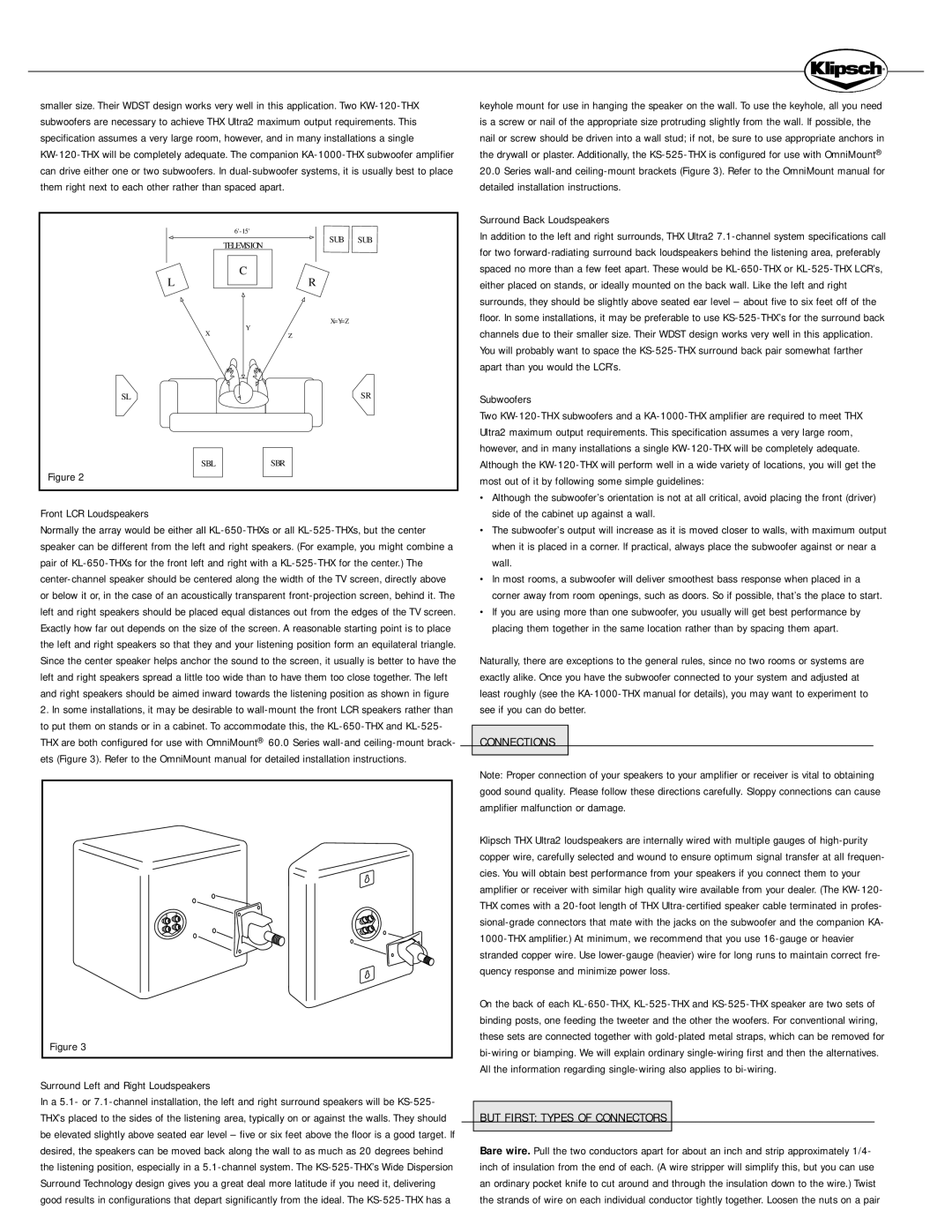Front LCR Loudspeakers
Normally the array would be either all KL-650-THXs or all KL-525-THXs, but the center speaker can be different from the left and right speakers. (For example, you might combine a pair of KL-650-THXs for the front left and right with a KL-525-THX for the center.) The center-channel speaker should be centered along the width of the TV screen, directly above or below it or, in the case of an acoustically transparent front-projection screen, behind it. The left and right speakers should be placed equal distances out from the edges of the TV screen. Exactly how far out depends on the size of the screen. A reasonable starting point is to place the left and right speakers so that they and your listening position form an equilateral triangle. Since the center speaker helps anchor the sound to the screen, it usually is better to have the left and right speakers spread a little too wide than to have them too close together. The left and right speakers should be aimed inward towards the listening position as shown in figure
2.In some installations, it may be desirable to wall-mount the front LCR speakers rather than to put them on stands or in a cabinet. To accommodate this, the KL-650-THX and KL-525- THX are both configured for use with OmniMount® 60.0 Series wall-and ceiling-mount brack- ets (Figure 3). Refer to the OmniMount manual for detailed installation instructions.
Surround Left and Right Loudspeakers
In a 5.1- or 7.1-channel installation, the left and right surround speakers will be KS-525- THX’s placed to the sides of the listening area, typically on or against the walls. They should be elevated slightly above seated ear level – five or six feet above the floor is a good target. If desired, the speakers can be moved back along the wall to as much as 20 degrees behind the listening position, especially in a 5.1-channel system. The KS-525-THX’s Wide Dispersion Surround Technology design gives you a great deal more latitude if you need it, delivering good results in configurations that depart significantly from the ideal. The KS-525-THX has a
•Although the subwoofer’s orientation is not at all critical, avoid placing the front (driver) side of the cabinet up against a wall.
•The subwoofer’s output will increase as it is moved closer to walls, with maximum output when it is placed in a corner. If practical, always place the subwoofer against or near a wall.
•In most rooms, a subwoofer will deliver smoothest bass response when placed in a corner away from room openings, such as doors. So if possible, that’s the place to start.
•If you are using more than one subwoofer, you usually will get best performance by placing them together in the same location rather than by spacing them apart.
Naturally, there are exceptions to the general rules, since no two rooms or systems are exactly alike. Once you have the subwoofer connected to your system and adjusted at least roughly (see the KA-1000-THX manual for details), you may want to experiment to see if you can do better.
CONNECTIONS
Note: Proper connection of your speakers to your amplifier or receiver is vital to obtaining good sound quality. Please follow these directions carefully. Sloppy connections can cause amplifier malfunction or damage.
Klipsch THX Ultra2 loudspeakers are internally wired with multiple gauges of high-purity copper wire, carefully selected and wound to ensure optimum signal transfer at all frequen- cies. You will obtain best performance from your speakers if you connect them to your amplifier or receiver with similar high quality wire available from your dealer. (The KW-120- THX comes with a 20-foot length of THX Ultra-certified speaker cable terminated in profes- sional-grade connectors that mate with the jacks on the subwoofer and the companion KA- 1000-THX amplifier.) At minimum, we recommend that you use 16-gauge or heavier stranded copper wire. Use lower-gauge (heavier) wire for long runs to maintain correct fre- quency response and minimize power loss.
On the back of each KL-650-THX, KL-525-THX and KS-525-THX speaker are two sets of binding posts, one feeding the tweeter and the other the woofers. For conventional wiring, these sets are connected together with gold-plated metal straps, which can be removed for bi-wiring or biamping. We will explain ordinary single-wiring first and then the alternatives. All the information regarding single-wiring also applies to bi-wiring.
BUT FIRST: TYPES OF CONNECTORS
Bare wire. Pull the two conductors apart for about an inch and strip approximately 1/4- inch of insulation from the end of each. (A wire stripper will simplify this, but you can use an ordinary pocket knife to cut around and through the insulation down to the wire.) Twist the strands of wire on each individual conductor tightly together. Loosen the nuts on a pair

